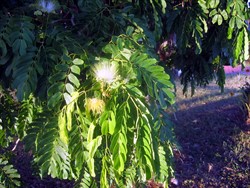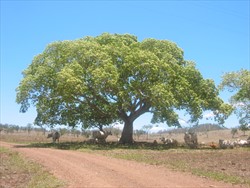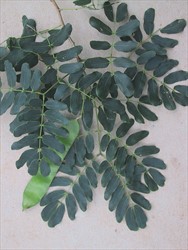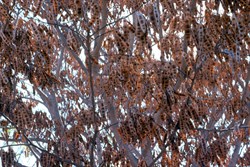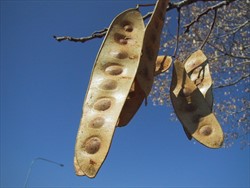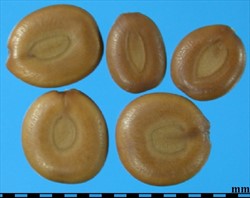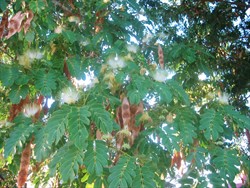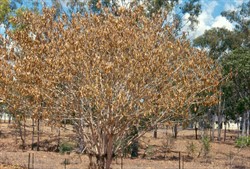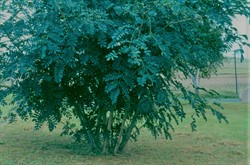Albizia lebbeck
Tropical Forages
Albizia lebbeck (L.) Benth.
Basionym: Mimosa lebbeck L.; Acacia lebbek (L.) Willd.; Mimosa sirissa Roxb.
Family: Fabaceae (alt. Leguminosae) subfamily: Caesalpinioideae (mimosoid clade*) tribe: Ingeae.
*Azani, N. et al. [97 authors from 54 institutions] 2017. A new subfamily classification of the Leguminosae based on a taxonomically comprehensive phylogeny. Taxon 66: 44–77.
Deciduous unarmed tree, growing to 30 m tall in native forests. In open situations, trees develop a spreading, sometimes multi-stemmed habit, to 25 m tall and 30 m across, with low branching. Can develop root suckers, and produces dense coppicing from cut stumps. Bark rough, grey, somewhat flaky; inner bark reddish. Stems terete, punctate, green, puberulous or pubescent when young, rapidly becoming grey brown with time. Leaves bipinnate with (1‒) 2‒4 (‒5) pairs of pinnae along a rachis 8–9 cm long. Pinnae comprise rachilla 5–10 cm long, bearing 3–11 pairs of asymmetric (midrib closer to the abaxial margin), oblong to elliptic-oblong leaflets 1.5–6.5 cm long and 0.5–3.5 cm wide, nyctinastic when young, fixed in older leaves. Inflorescence a terminal or axillary (often 2 or more per axil), 5–9 cm diameter semi-globular cluster of 15‒40 flowers; peduncles 5‒10 cm long. Flowers, fragrant, with pedicels 1.5‒4.5 (-7) mm long; calyx puberulous, 3.5‒5 mm long; corolla 5‒11 mm long, terminating in 5 triangular lobes pubescent at the apex; filaments numerous, 1.5‒3 cm long, fused at the base, predominantly white to cream in colour, tipped with pale green, and becoming dark yellow with age. Pods flat, glabrous, coriaceous, indehiscent, 12‒35 cm long, and 3‒6 cm wide, undulating along the sutures, light yellowish-brown when mature, containing 3‒12 seeds. Seeds brown in colour, flattened ellipsoidal, 7‒11 mm x 6‒9 mm × 1‒1.5 mm; (5,000‒) 7,000–11,000 (‒16,000) per kg.
Africa: lebbekboom (Afrikaans); daqn el-Basha, dign el basha, labakh, laebach, lebbek (Arabic)mkingu, mkungu (Swahili); lebbek (Ethiopia)
Asia: chreh (Cambodia); kokko (Myanmar); tekik, kitoke, tarisi (Indonesia); ka `sê, mai thone (Laos); batai, batai batu, kungkur, oriang (Malaysia); aninapala, langil (Philippines); chamchuri, kampu, ka se, khago, cha kham, chamchuri, kampu, phruek, suek (Thailand); bồ kết tây, lim xanh, trât (Vietnam)
English: acacia tree, Broome raintree, East Indian walnut, flea tree, frywood, Indian siris, koko, lebbek, lebbeck, lebbektree, powderpuff-tree, rain tree, raom tree, rattlepod, siris tree, soros-tree, Tibet tree, woman's-tongue-tree
Europe: bois noir, bois savane, ebénier d'Orient; tcha tcha (Creole) (French); Lebachbaum, Andamanen-kokko (German); albizia indiana (Italian)
Indian subcontinent: bage, begemara, bengha, beymada, bhandir, diriina, chinchola, darshana, dieng-salvrin, dirasan, dirasanam, dirisana, doddabagi, gachoda, garso, goddahunse, harreri, hirih, kala siris, kalbaghi, kalshish, karuvagei, katu vagai, katvaghe, kinhi, kokko, kona, kothia koroi, lasrin, mathirsi, moroi, munipriva, nenmenivaka, salaunjal, samkesar sirisha, sarin, sarshio, seleyadamara sirsul, shrin, shireesha, shirish, shirson, sirai, sirar, siras, sirin, siris, sirish, sirisah, tantia, vagai, vagei, vaka, vakai, vellavaka, velvgai, voghe; सरस saras (Hindi); khok (Manipuri); சிரிடம் sridam (Tamil); vaga (Malayalam); tinia (Urdu); कालो शिरीष kaalo siris, kalo siris (Nepali); mara, maara, sooriya mara, suriya mara (Sinhala), bhandi, sirisah (Tamil), kona, vageri, vakai siridam (Sri Lanka)
Latin America: bano-oriental, ébano-oriental, coração-de-negro, língua-de-mulher, língua-de-sogra (Brazil); canjuro (Mexico); mata-raton (Panama); acacia; baile de caballero (Venezuela); acacia chachá, algarroba de olor, amor plantónico, aroma, aroma fracesca, cabellos de ángel, faurestina, florestina, lengua de mujer, lengua viperina (Spanish)
Pacific: schepil kalaskas (Carolines); 'arapitia (Cook Islands); vaivai ni vavalagi (Fiji); white monkeypod (Hawaii); kalaskas, mamis, trongkon kalaskas, trongkon-mames, tronkon mames (Marianas Islands); gumorningabchey, ngumormingobchey (Yap)
Lesser Antilles: vieille fille, shack-shack
Madagascar: bonara, bwar nwar; fany; faux mendoravina
Native:
GRIN does not suggest countries of origin. However, PROSEA 4 lists the Indian sub-continent and areas of SE Asia with a marked dry season (e.g. NE Thailand, the E islands of Indonesia, and the monsoon areas of N Australia).
Naturalized:
Many countries of the tropics and subtropics
Forage
A nitrogen-fixing tree, proposed as an alternative forage to Leucaena leucocephala in more acid soils, particularly with the advent of the leucaena psyllid (Heteropsylla cubana), but to date has not been adopted commercially to any extent. The pods contain saponin and are not eaten in large amounts by sheep, although cattle eat them readily.
Environment
Although leaves fall in winter, valuable shade is provided during the heat of summer. The extensive, shallow root system makes it a good soil binder and suited to soil conservation and erosion control; recommended for eroded lands and erosion control. Foliage can tolerate a moderate degree of salt spray making A. lebbeck useful for stabilising susceptible land in coastal areas; also used in rehabilitating degraded land by virtue of nitrogen fixation and nutrient cycling with leaf drop.
Other
Various parts of the tree are used in folk remedies for many ailments. Used as an ornamental and avenue tree, and sometimes as a shade tree in coffee, cocoa and tea. The bark contains saponins and tannins, used for making soap and in tanning, respectively. A. lebbeck provides quality hardwood (cabinet, veneer, construction), fuel-wood and charcoal, and honey (source of nectar and pollen). The bark has also been used as a fish poison.
Soil requirements
Occurs naturally on soils overlying basalt, and among sandstone boulders and basalt outcrops on breakaway or scree slopes. It is also found in riparian situations, and on stabilized dunes or low lateritic ledges above the beach. While it prefers well-drained soils of moderate to high fertility, it will grow on less fertile soils, but is not well adapted to heavy clay or waterlogged soils. It is adapted over a wide range of pH from acid to alkaline, and also tolerates moderate soil salinity.
Moisture
While it probably originates from areas with a mean annual rainfall of 1,300‒1,500 mm and a very dry winter, it grows well in areas with 400‒2,500 mm rain/year. It is very drought tolerant, being found in areas with rainfall as low as 300‒400 mm/yr.
Temperature
In its natural habitat in Himalayan valleys, it is found up to 1,600 m asl, but has been grown successfully as high as 2,150 m (Querétaro, Mexico, 21°00' N), where the 24-hour annual average temperature is 18.7 °C (SD 2.56), but also near sea level in the tropics (Dar es Salaam, 6°48' S) where the 24-hour annual average temperature is 25.6 ºC (SD 1.64). Tops of young plants are killed by frost, but plants coppice up from the base with the onset of warm conditions. In SE Queensland, Australia, Albizia lebbeck has grown well in an area (Gayndah 25°37' S, 160 m asl) where 24-hour annual average temperature is 20.7 ºC (SD 4.63) and receiving over 12 frosts per year, some quite severe (<-4 ºC).
Light
Found in deciduous and semi-deciduous monsoon forests and rainforests in its native habitat, and in a variety of situations in the humid and semi-arid tropics and subtropics.
Reproductive development
Flowering begins with the resumption of growth towards the end of the dry season, continuing into the wet season. Pods mature in the early dry season, remaining on the tree for 3‒4 months or well into the following flowering season. Unless trees have been frequently coppiced, they can produce large amounts of seed every year. Flowering can occur on plants as young as 10 months old. Flowers are insect-pollinated.
Defoliation
In the seasonally dry tropics, growth follows a seasonal pattern, with plants exhibiting early dry season dormancy, becoming deciduous 2‒3 months later, remaining leafless for 1‒2 months, and growth resuming towards the end of the dry season. In the subtropics, leaf drop occurs during the winter, which largely coincides with the dry season. Plants re-shoot with the onset of warmer weather. Albizia lebbeck is not productive under repeated cutting (contrast with leucaena), and should only be cut once or twice per year. It is therefore not suited to regular browsing. If older stems are cut for fuel-wood and forage, plants coppice vigorously in recovery.
Fire
Older plants and trees withstand grass fires of considerable intensity. Above-ground growth of young trees is killed but new growth usually follows.
Establishment
Unlike many tropical legumes, A. lebbeck is not particularly hard-seeded and often a large proportion of seed germinates rapidly without any treatment. There are various suggestions for pre-treatment of seed. Pour boiling water over seeds, about 1 litre water per 250 g of seed or about 5 times as much water as seed, stir gently, pour off after 2 minutes (or as specified), replace with tap water and soak overnight. Alternatively, hard seed can be scarified by immersing in boiling water for 3–10 seconds and then cooled rapidly, or 3 minutes in water at 50 ºC. If the seed coat is very thin, boiling water may be harmful. It is fairly promiscuous in its rhizobial requirements, and seed inoculation is rarely necessary. Plants can be established by sowing directly into the ground or into containers, or planting out as bare-rooted specimens. Germination is epigeal. Seedlings develop a long, stout taproot at an early age and are drought-tolerant. In cooler or drier environments, early seedling development may be slow, and for direct sowing, grass and weed control is necessary for a year or more after sowing. In the sub-humid subtropics of Australia, it has taken over 3 years for plants to reach sufficient size for utilisation by cattle. However, in warmer, more humid conditions, plants can ultimately reach 5 m tall in the first year.
To reduce the field establishment period and to maintain better control of establishment conditions, seedlings can be raised in nursery beds then transplanted once the top can be pruned to 10 cm and the root to about 25 cm. This may take as long as 12–18 months, or much less with good conditions. Tubed stock raised in plastic sleeves and grown under ideal conditions can reach transplanting size (20–30 cm) in 3 months. For production of bare rooted seedlings or stumps, seeds are sown in rows about 15 cm apart with the seeds spaced at 2–3 cm within the row and about 1 cm deep. About 40 g seed is required for sowing 1 m2 of nursery bed. Best seedling development is obtained in full sunlight.
Fertilizer
A. lebbeck is not particularly responsive to applied phosphorus, possibly due to indigenous arbuscular mycorrhizal association, but application of a mixed fertilizer may enhance early growth on poorer soils e.g. 50 g of 15:15:15 NPK per seedling applied after 1 month, and further applications of 100 g after 2–3 months, and at the end of the rainy season. Fertilizer should be spread over a 25 cm radius around the plant, or in holding depressions dug 20 – 30 cm above the plants if establishing on slopes.
Compatibility (with other species)
Grasses, particularly more shade tolerant species, grow effectively under A. lebbeck, where light transmission is about 80% through the canopy of developing trees, and 40–50% through the canopy of mature trees.
Companion species
Due to the relatively slow early growth of A. lebbeck in some situations, it is probably best not to sow companion species until the young trees are well established. Then, associated grasses should be the more shade tolerant, nitrogen responsive species recommended for the area. Where appropriate, Megathyrsus maximus cultivars should be considered. Twining legumes have a tendency to grow over young trees and suppress growth.
Pests and diseases
Establishment can be affected by attack on young plants by rodents and grazing animals. Once mature, leaves are largely unaffected by insects, but young leaves may be subject to heavy predation by larvae of the grass yellow butterfly, Eurema hecabe (Lepidoptera: Pieridae). This appears to be a short-lived effect. The most serious pests are bark-feeding larvae of longicorn beetles (Coleoptera: Cerambycidae) that can cause dieback by complete girdling of 40–100 mm diameter stems. Seed destruction by seed borers, Bruchus bilineatopygus (Bruchidius bilineatopygus) and Bruchidius sparsemaculatus (Coleoptera: Bruchidae), reduces the percentage fertility of seed. Establishing seedlings can be attacked by termites, and a psyllid, Psylla hyalina (Hemiptera: Psyllidae) that can also damage saplings. Other insects reported on A. lebbeck are sap suckers, Ferrisia virgata (Hemiptera: Pseudococcidae) and Oxyrachis tarandus (Hemiptera: Membracidae), a bark-eating caterpillar, Indarbela quadrinotata (Lepidoptera: Metarbelidae), and leaf feeders, Glyphodes pyloalis (Lepidoptera,:Pyralidae) and Spirama retorta (Lepidoptera: Noctuidae). Termites and wood borers also attack timber. While insects can be a minor nuisance in most countries, reports of serious damage are often generated from its centre of origin, India.
Various fungal leaf diseases are reported from forest nurseries in India, including leaf web blight caused by Rhizoctonia solani, and leaf spots caused by Periconia byssoides and Colletotrichum capsici. In 2000, trees in Oman wilted and died, following dieback of large branches, due to infection by the fungus, Scytalidium dimidiatum.
Ability to spread
Seed is retained in the light pods until they fall, and then dispersed by strong wind and surface flow. Seed can be spread through ingestion by cattle, but does not pass through small ruminants.
Weed potential
It is considered to pose a high weed threat by Pacific Island Ecosystems at Risk (PIER) as well as by authorities in Florida and the Comoros Archipelago. In Australia it received a weed risk assessment rating of 4, meaning “more information needed”. It is unlikely to become a serious weed where grazing livestock are present.
Nutritive value
Green leaves (CP 16–23%, NDF 41‒35%, IVDMD 45–70% depending on age) are short-lived and deciduous, and present during a large part of the rainy season. Leaves, flowers and pods fall to the ground gradually during the dry season and can be browsed on the ground. Fallen leaf (CP 9‒13%, NDF 49%, IVDMD 44%) and flowers (CP 23%; IVDMD 57%) are readily eaten by sheep. Pods also are a rich protein source (CP 19%, NDF 55%) and are available over a longer period than leaf or flower.
Palatability/acceptability
Green leaf, fallen leaf and flowers have all been shown to be highly palatable and of high nutritive value for sheep, although observation suggests A. lebbeck may not be as readily eaten by cattle. Young leaf tastes bitter and intake may be limited when offered as the whole diet. Pods are not eaten in large amounts by sheep, although cattle eat them readily
Toxicity
Leaves are free of toxins and tannins, and low in soluble phenolic compounds. Flowers contain no adverse constituents. Pods contain saponins which may limit intake but appear to have no other adverse effect. Some claim of toxicity in seed.
Feedipedia link
Dry matter
In a stand growing in shallow soil in a subtropical 750 mm rainfall area in Australia, estimates of average annual production of edible dry matter varied from 1.7 t/ha/yr in stands of mature trees completely pruned back to the stem once every three years, to 2.5 t/ha/yr in hedgerows at a row distance of 3 m and defoliated by cattle twice a year. In the more humid, more tropical environment of Puerto Rico, above ground biomass in a dense tree stand after 2 years was 17.4 t/ha, and 29.5 t/ha after 3 years, with leaves comprising 13–23% of the dry matter. Correcting for DM % in the second example, these are probably comparable.
In the seasonally dry tropics of Australia, edible dry matter per tree in the litter from mature trees in the absence of cutting or browsing, was measured at roughly 60 kg leaves, 30 kg flowers, and 30 kg pods (see also “Nutritive value”). Mature stands of A. lebbeck may drop 5 t/ha/yr of leaf.
Animal production
There is little information on ruminant performance benefits from A. lebbeck, other than to extrapolate from nutritional value and intake studies. The main value is in providing edible material from the trees as supplement to poor quality grass, which improves overall feed intake. Rabbits too have shown good growth performance when fed A. lebbeck leaf comprising 50% of the diet. There is also further benefit due to improved nitrogen supply to grasses growing in the vicinity of trees.
2n = 26. Some provenance selection has been conducted showing heritable traits.
Seed is harvested manually. As with many legumes, there is no need to wait until pods are dry to harvest seed. Pods are mature when they have turned light yellow and should be harvested when the last patches of green are disappearing. It is important that collection is not delayed as insects can very quickly infest mature pods. Bags carrying immature pods should be kept open during transport to facilitate ventilation thus avoiding fungal growth. Pods should then be dried until they rattle and become brittle (preferably in the sun, but protected from the ravages of seed-destroying beetles). Threshing can be difficult since pods are indehiscent. Seed is extracted by beating or in a flail thresher. After extraction the seed is dried directly in the sunlight and pod segments and debris removed using appropriate sieves, followed by winnowing. Less mature pods may also be infested by insects, so temporary storage should be as short as possible as the insects develop during this phase. Lowering seed moisture levels below 10% and dusting with malathion or pyrethroid dust reduces chances of post-harvest bruchid damage. Once sufficiently dried, seed should be stored hermetically.
Trees are susceptible to triclopyr, either as a basal bark or cut stump treatment. Small seedlings can be hand-pulled.
- Drought tolerant.
- Wide soil pH adaptation.
- Salt tolerant.
- Wide climatic adaptation.
- High feeding value.
- Coppices freely.
- Few diseases.
- Multi-purpose (browse, timber, fuel-wood, honey, soil conservation).
- Not adapted to heavy clay soils.
- Tops of young plants killed by frost.
- Needs good drainage.
- Seed subject to insect damage.
- Weed potential.
Hegde, N. and Relwani, L. (1988). Psyllids attack Albizia lebbeck Benth. in India. Nitrogen Fixing Tree Research Reports 6:43–44.
Kennedy, P.M., Lowry, J.B., Coates, D.B. and Oerlemans, J. (2002) Utilisation of tropical dry season grass by ruminants is increased by feeding fallen leaf of siris (Albizia lebbeck). Animal Feed Science and Technology 96:175–192. doi.org/10.1016/S0377-8401(01)00333-9
Larbi, A., Smith, J.W., Adekunle, I.O. and Kurdi, I.O. (1996) Studies on multipurpose fodder trees and shrubs in West Africa: Variation in determinants of forage quality in Albizia and Paraserianthes species. Agroforestry Systems 33:29–39. doi.org/10.1007/BF00122887
Larbi, A., Smith, J.W., Kurdi, I.O., Adekunle, I.O., Raji, A.M. and Ladipo, D.O. (1996) Feed value of multipurpose fodder trees and shrubs in West Africa: Edible forage production and nutritive value of Millettia thonningii and Albizia lebbeck. Agroforestry Systems 33:41–50. doi.org/10.1007/BF00122888
Lowry, J.B. (1992). Albizia lebbeck (L.) Benth. In: Mannetje, L.’t and Jones, R.M. (eds) Plant Resources of South-East Asia No. 4. Forages. Pudoc Scientific Publishers, Wageningen, the Netherlands. p. 169–171. edepot.wur.nl/327785
Lowry, J.B., Lowry, B.C. and Jones R.J. (1988) Enhanced grass growth below a canopy of A. lebbeck. Nitrogen Fixing Tree Research Reports 6:45–46.
Lowry, J.B., Prinsen, J.H. and Burrows, D.M. (1994) Albizia lebbeck - a promising forage tree for semiarid regions. In: Gutteridge R.C. and Shelton H.M. (eds) Forage tree legumes in tropical agriculture. CAB International, Wallingford, Oxon, UK. p. 75–83. cabi.org/isc/abstract/19940601677
Parrotta, J.A. (1988) Early growth and yield of Albizia lebbeck at a coastal site in Puerto Rico. Nitrogen Fixing Tree Research Reports 6:47–49.
Pradhan, I.P. and Dayal, R. (1981) Farm forestry in agricultural economy. Indian Forestry 107:665–667.
Prinsen, J.H. (1986) Potential of Albizia lebbeck (Mimosaceae) as a tropical fodder tree - a review of literature. Tropical Grasslands 20:78–83. bit.ly/3959lyc
Toky, O.P., Kumar, N. and Bisht, R.P. (1996) Variation in growth of 3-year old provenance trial of Albizia lebbek (L.) Benth. in arid India. Silvae Genetica 45:31–33. bit.ly/399BbJE
Uddin, M.B., Mukul, S.A., Khan, M.A.S.A. and Hossain, M.K. (2007) Effects of phosphorous fertilizer on seedlings growth and nodulation capabilities of some popular agroforestry tree species of Bangladesh. Journal of Forestry Research 18:283–286. doi.org/10.1007/s11676-007-0054-4
None released.
None reported.
